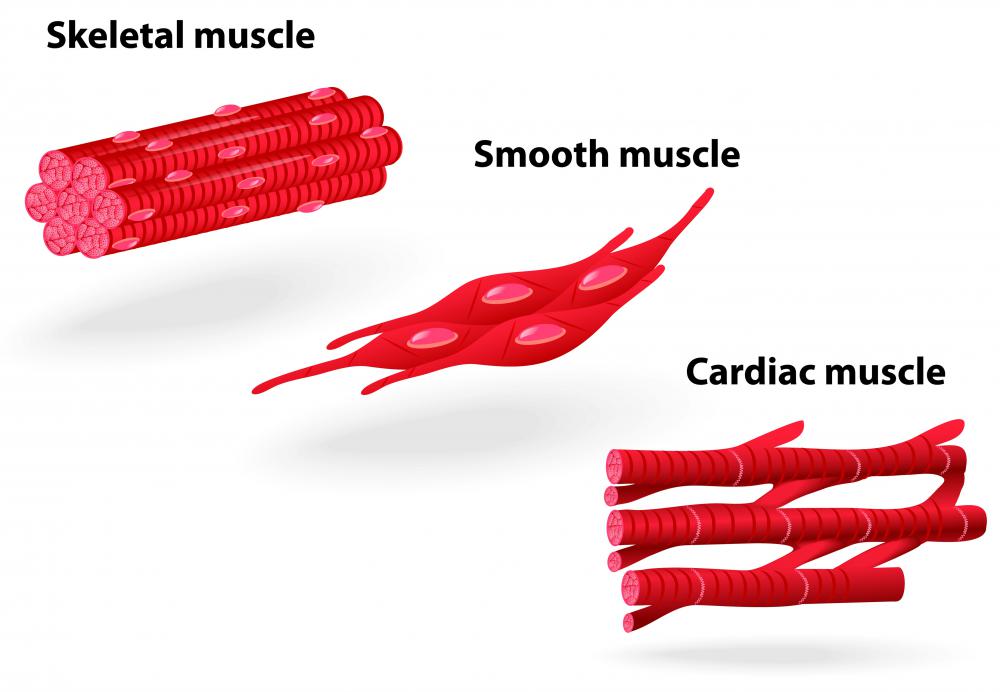At TheHealthBoard, we're committed to delivering accurate, trustworthy information. Our expert-authored content is rigorously fact-checked and sourced from credible authorities. Discover how we uphold the highest standards in providing you with reliable knowledge.
What Is the Role of the Muscular System?
The primary role of the muscular system is to make other body organs move through the use of muscles. The muscular system also plays an important role in digestion, heart contraction and blood flow, organ protection, heat production, and maintenance of the body’s shape. Muscles have been assigned with Latin names in order to describe their shape, location, action, and size. For instance, deltoid means triangular muscle, abdominis means abdominal muscle, flexor means flexion muscle, and minimus means smallest muscle.
The contraction of cells that make up the muscles is responsible for the production of movement. Most muscles accomplish their function in pairs, each muscle with an action that opposes the action of another muscle. This means that the contraction of one muscle results in the relaxation of another muscle. In bending the knee, for instance, the hamstring muscle contracts as the quadriceps relaxes. When the knee is straightened, the quadriceps contracts as the hamstring relaxes.

Three types of muscles – skeletal, cardiac, and smooth muscles – make up the muscular system. The role of more than 640 skeletal muscles is to produce voluntary bone movement and, together with bones, to give the general shape of the body. Skeletal muscles, which constitute 40% of the weight of the body, are also known as striated muscles because of the stripes or striations that mark the skeletal muscle fibers. Bones are attached to the origin and insertion of skeletal muscles by means of tendons. Origin is the end of the skeletal muscle that has little or no movement, while insertion is the end that moves.

Cardiac muscles produce involuntary movement in the heart. This means cardiac muscles contract automatically even without any stimulus from the nervous system. Moreover, cardiac muscles continuously contract throughout a person’s lifetime. The striations in cardiac muscle fibers are not as clear as those in skeletal muscle fibers. Cardiac muscle contractions pump blood to all parts of the body.

Involuntary contractions of smooth muscles enable food to pass along the digestive tract during digestion. Therefore, smooth muscles can be found lining the esophagus, stomach, and intestines, although they are also present in blood vessels and the urinary bladder. Unlike the skeletal and cardiac muscles, striations cannot be found in smooth muscles. The contraction of smooth muscles is much slower than that of skeletal muscles.

The muscular system and skeletal system work together to produce body movements; one will not be able to do its job without the other. Bones are responsible for the movement of the body into various positions, but they cannot move by themselves. Only muscles can move bones through contractions.
AS FEATURED ON:
AS FEATURED ON:














Discussion Comments
What is the purpose of smooth muscles in blood vessels? I've not heard of this before. Do they help with blood flow? I guess muscles are far more widespread in our body than we realize and they are found in the most peculiar areas.
@ddljohn-- You actually gave a great example about why the muscular system is important. It basically keeps things together and supports the other systems so that everything functions as it should. Muscles keep tissues and bones and give them both a barrier and the strength to move. Their importance is undeniable.
You are absolutely right that muscles can weaken. We all learned in school that if we don't eat right when we exercise, we may burn muscle instead of fat, for example.
As someone with repeated back injuries due to weak back muscles, I've understood the importance of the muscular system very well recently.
I always thought that we are born just as we need to. But now I understand that our skeletal system and muscle strength is not automatically normal or good from birth. Especially in the case of muscles, the strength can be gained and lost and we have to work at it.
Since I have weak back muscles, when I am doing movements involving the back, abnormal weight and tension is placed on my skeletal system. This has led to a ruptured spinal disc and few related injuries like spasms. If my muscles were strong, they would take the weight and pressure as I move, and little to no tension would be placed on my spine. I'm trying to strengthen these muscles with back exercises but according to my doctor, it may take years.
Post your comments